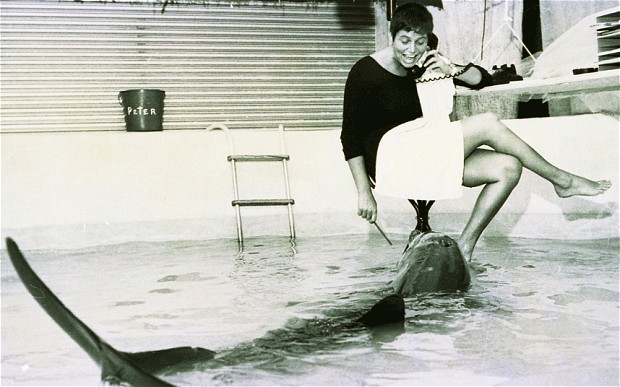‘A dolphin’s teeth are small and sharp, clean rows, tilted up in a smile that’s not a smile. Each tooth is perfectly even, and even though they don’t break the skin, they do mark her temporarily, flesh turning white then red.’
The real Margaret was not a scientist. She was a young lady who knocked on the door of a research institute in St Thomas and offered to help with the dolphins. Somehow, in 1963, that kind of thing still worked. Not only did they allow Margaret Howe to come back and take notes, Dr Lilly eventually took her suggestion to fill the house with water so she could live and work with Peter full-time.
While my Margaret is shy, coming of age along with her dolphin companion, the real Margaret was confident and self-possessed. She believed fully in the project and in Peter, and both she and Dr Lilly stood by the conclusion that they’d taught English to this dolphin. Their colleagues did not agree. The grant funding the project was not for dolphins to learn English, but for humans to learn ‘dolphinese’. While the rest of the scientists were working to see if the dolphins had language at all, trying to get them to communicate verbally across a barrier, Margaret moved into a house full of water and entered into an intimate relationship with a cetacean.
I was first drawn by the more sensational and unbelievable elements of this story: sex, drugs and dolphins. I was shocked by the hubris of such an experiment and intrigued by the confidence that made Howe and Lilly believe themselves capable of communicating across species. I tried to imagine Margaret and Peter’s relationship in terms of Freud and other pervading psychological theory of the time. There was a sense then that the human mind had been solved, interpreted, theorized, that human connection and the complexities of love relationships could translate easily.
With all of that in mind, this story only really became my own when I started thinking about sound. The dogged repetition of teaching – breaking language down into repeatable bits that might, hopefully, eventually, be understood, felt infinitely optimistic and somewhat Sisyphean (and, at times, akin to my own struggles with language while teaching and writing). I started this story with words of comparison, trying to draw the two species closer together. I started with repetitions and variations, with short, monosyllabic incantations that I imagined might have filled the head of someone whose main conversation partner was a dolphin learning to speak. I added in an element of violence, a hint of discomfort, and I had found my first lines.
When researching the real events, I stuck to the notes Margaret Howe took at the time and Dr Lilly’s writings about dolphins. I avoided audio and video files until I was done with my draft. I didn’t want reality to overwrite the story that was forming in my head. I wanted to imagine it all as they saw it. I wanted to believe, with Margaret and Dr Lilly, that Peter could speak. When I finished, I did listen to the tapes. Here is one instance Dr Lilly insisted showed Peter’s ability to speak:
What I hear is not proof, but hope. In this audio is the desire for connection we find in all language – that we might communicate some truth with another unknowable being, and see ourselves reflected back.

Photographs © BBC






